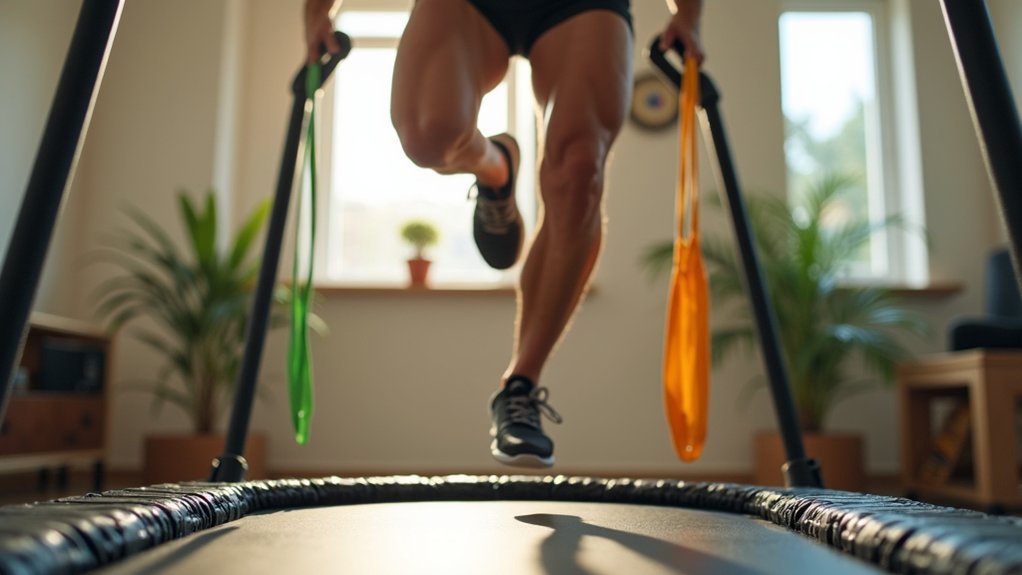Jumping workouts build lasting muscle stamina by triggering rapid stretch-shortening cycles that improve motor unit recruitment and optimize muscle-tendon stiffness. These explosive movements primarily activate fast-twitch muscle fibers, increasing your lactate threshold and ATP resynthesis rates for sustained effort. Regular plyometric training enhances neuromuscular coordination while maintaining these essential fast-twitch fibers that naturally decline with age. Just six weeks of consistent jumping can markedly boost your endurance capabilities and transform your overall athletic performance.
The Science Behind Plyometric Training and Muscle Stamina

While traditional resistance training builds raw strength, plyometric movements transform that power into lasting muscle stamina through unique neurological and physiological adaptations.
When you perform explosive jumps, your muscles undergo rapid stretch-shortening cycles that enhance motor unit recruitment and neural efficiency.
The beauty of plyometrics lies in how they optimize your muscle-tendon stiffness, improving force development rates while reducing energy leaks.
Your body learns to utilize elastic energy through tendon recoil, remarkably cutting the metabolic cost of movement. This training simultaneously increases your lactate threshold and ATP resynthesis rates, allowing you to sustain effort longer.
Research confirms these benefits aren’t theoretical—just six weeks of consistent jumping workouts can considerably boost your endurance capabilities while reinforcing the neural pathways that create automated, energy-efficient movement patterns. A comprehensive eight-week plyometric training program shows significant improvements in explosive strength metrics among elite basketball players.
How Jumping Activates Fast-Twitch Muscle Fibers
When you explode upward in a jump, your body instantly recruits its fast-twitch muscle fibers – the powerful engines behind all explosive human movement. These fibers, unlike their slow-twitch counterparts, activate rapidly during high-intensity actions, making jumping an ideal training method to engage them.
| Jump Type | Muscle Activation |
|---|---|
| Box Jumps | Quadriceps, Glutes |
| Depth Jumps | Calves, Hamstrings |
| Scissor Jumps | Hip Flexors, Core |
| Tuck Jumps | Full-body, Abdominals |
Your fast-twitch fibers naturally decline with age unless you consistently challenge them. Incorporating a variety of plyometric exercises into your training regimen creates more comprehensive muscular development. Through regular plyometric training, you’ll enhance neuromuscular coordination and improve your body’s ability to recruit these powerful fibers efficiently. This adaptation doesn’t just boost explosive power—it creates lasting improvements in your muscle stamina and athletic performance.
Rebounding’s Impact on Neuromuscular Efficiency

Rebounding exercises train your fast-twitch muscle fibers through repeated explosive contractions that require rapid force generation.
Your motor patterns become more efficient as consistent jumping sequences reinforce ideal movement pathways between your nervous system and muscles.
The stretch-reflex mechanism gradually enhances with each landing-to-takeoff shift, improving your body’s ability to quickly store and release elastic energy during dynamic movements. Research shows that REBOUND technique can deliver superior results in countermovement jump and sprint performance compared to pause techniques, making it particularly effective for sports requiring stretch-shortening cycle actions.
Fast-Twitch Muscle Activation
Unlike slow-twitch endurance fibers, fast-twitch muscle fibers spring to life during explosive jumping exercises, creating a cascade of neuromuscular benefits that extend far beyond the moment of takeoff. Your body’s phosphocreatine systems activate instantly during these movements, training your muscles to recycle energy substrates more efficiently. Implementing contrast method training can significantly enhance these adaptations by pairing heavy compound exercises with explosive movements.
| Jump Type | Primary Benefit | Training Effect |
|---|---|---|
| Box Jumps | ATP-CP System Enhancement | Increases power output capacity |
| Hurdle Hops | Reflex Potentiation | Optimizes tendon elastic energy storage |
| Depth Jumps | Triple Extension Synchronization | Minimizes energy leakage during rebounds |
When you perform explosive jumps with minimal ground contact time, you’re forcing larger motor units to activate, training your muscles to generate maximum force quickly while delaying fatigue. This neuromuscular synchronization improves communication between your brain and muscles, creating lasting stamina improvements.
Motor Pattern Reinforcement
Through repetitive, three-dimensional movements, your neuromuscular system undergoes profound adaptations during rebounding exercises. Each jump strengthens the connection between your brain and muscles, enhancing proprioception and coordination as your body continuously adjusts to the unstable surface.
You’ll notice improved balance and posture as your postural muscles strengthen through consistent practice. The rhythmic motion trains your protective reflexes while simultaneously engaging multiple muscle groups, optimizing recruitment patterns and reducing muscular stress.
What’s particularly valuable is how these benefits transfer to everyday activities. Your walking gait improves, you react faster to physical challenges, and you’ll move more efficiently across various surfaces.
This enhanced neuromuscular efficiency doesn’t just build stamina—it creates lasting adaptations that improve functional performance and injury resistance in all your activities.
Stretch-Reflex Enhancement
The stretch reflex—your body’s automatic muscle contraction response to sudden stretching—becomes remarkably enhanced during consistent jumping workouts.
Each time you land and immediately rebound, you’re training your neuromuscular system to fire more efficiently. This rapid stretch-shortening cycle optimizes how your muscles recruit motor units, improving synchronization between opposing muscle groups and reducing energy waste.
You’re fundamentally programming your body to respond faster with less effort.
Mini-trampoline training particularly refines your proprioceptive system, enhancing balance and functional mobility.
Even more fascinating is how rebound movements can decrease neural inhibition in muscles, allowing fuller activation during explosive movements.
The result? Your muscles learn to communicate better, reducing unnecessary co-contractions and improving coordination between your core and limbs during dynamic movements.
Age-Specific Benefits of Trampoline-Based Workouts

Trampoline workouts deliver unique benefits throughout your lifespan, from building bone density and motor skills in youth to preventing falls and maintaining mobility in seniors.
Your twenties and thirties maximize muscle activation and metabolic gains, while middle age benefits include preserving functional strength and mitigating age-related decline.
You’ll find trampolining adapts perfectly to your changing body, offering scaled intensity options that maintain exercise effectiveness regardless of your age or fitness level. Mini-trampolines provide a safer exercise option compared to large backyard trampolines, especially for adults seeking stability during workouts.
Young Bodies, Strong Foundations
While children and teenagers undergo critical physical development, trampoline-based training offers remarkable benefits that can shape their athletic abilities for life. You’ll find that young bodies develop stronger bones through increased density, laying the groundwork for lifelong skeletal health. Research shows that rebounding can be particularly beneficial for children with cystic fibrosis by improving their pulmonary function.
| Benefit | Impact on Young Bodies |
|---|---|
| Bone Density | Stimulates osteogenesis, reducing future osteoporosis risk |
| Coordination | Develops motor skills through dynamic movements |
| Muscle Growth | Builds strength in legs and core during essential growth periods |
Regular trampoline sessions improve your child’s cardiovascular fitness, increasing their VO2 max and heart efficiency. These workouts enhance flexibility while simultaneously building core stability—a combination that’s particularly beneficial during developmental years. The balance skills they’ll gain now will translate to better athletic performance and fewer injuries throughout their sporting career.
Mid-Life Bounce Benefits
As we advance into midlife, our bodies face new challenges that demand smarter exercise choices. Trampoline workouts deliver remarkable age-specific advantages for your changing physiology.
You’ll preserve bone density through low-impact loading that stimulates osteogenic activity without stressing joints. The unstable surface trains proprioception, improving balance by up to 35% and reducing fall risk as you strengthen core stabilizers.
You’re burning calories comparable to running while absorbing 80% of impact forces, protecting your joints from wear. This efficiency raises your heart rate quickly with lower perceived exertion. Rebounding also effectively slows muscle weakness associated with aging, helping you maintain strength and functionality longer.
The full-body engagement strengthens your pelvic floor and builds rotational power for real-world movements.
Senior Rebound Advantages
Entering your senior years doesn’t mean abandoning dynamic exercise—in fact, it’s precisely when your body needs specialized movement the most. Mini-trampolines offer remarkable benefits with minimal risks.
Just 14 weeks of regular rebounding can improve your fall-recovery balance by approximately 35%, while strengthening bones that might otherwise weaken with age. Postmenopausal women experience significant bone density improvements after only 12 weeks of 30-minute sessions, particularly in vulnerable hip and spine areas.
Beyond physical benefits, trampoline workouts enhance your confidence and reduce fall anxiety through improved spatial awareness. Rebounding stimulates the vestibular system for better balance and stability that seniors often struggle to maintain.
The low-impact nature of bouncing protects your joints while still engaging your entire body—strengthening your core, improving walking speed, and enhancing daily movement capabilities like stair climbing and standing from seated positions.
Progressive Jumping Protocols for Endurance Development
Despite being commonly associated with explosive power training, progressive jumping protocols offer remarkable benefits for enhancing muscle stamina and endurance.
These workouts improve your running economy and time-trial performance while engaging both fast-twitch and slow-twitch muscle fibers.
Progressive jump training optimizes both muscle fiber types, enhancing running efficiency and competitive performance metrics.
You’ll notice significant adaptations as your body responds to this training style. Research shows that plyometric jump training increases muscle fiber size by up to 30% across type I, IIa, and IIa/IIx fibers.
This translates to improved force production during extended activity periods.
Start with lower intensity jumps and gradually progress to more challenging movements.
Even if you’re primarily an endurance athlete, you’ll benefit from enhanced sprint performance and better neuromuscular coordination.
This systematic approach guarantees your muscles adapt properly while minimizing injury risk, making it effective for all fitness levels. Like the study found with progressive movement training, these protocols can lead to significant increases in vertical jump performance and power output over traditional training methods.
Combining Rebounding With Strength Training for Optimal Results
Rebounding workouts paired with strategic strength training create a potent synergy that maximizes muscle stamina beyond what either approach achieves alone.
The 30-second rebounds between strength sets boost muscle improvement by 25%, while stimulating both fast and slow-twitch fibers for complete muscular development.
You’ll experience enhanced recovery as rebounding’s lymphatic stimulation clears metabolic waste between sets. This combination also creates metabolic magic – improving insulin sensitivity for better nutrient partitioning while reducing inflammation that might otherwise limit training frequency.
The proprioceptive challenge of an unstable surface refines your movement patterns for compound lifts, while the low-impact resistance strengthens joints without excessive compression. Rebounding enhances this benefit by providing strengthening effects with less joint impact than traditional high-impact exercises.
For ideal results, try HIIT-style pairings like 1-minute jumps between deadlift sets to simultaneously build cardiovascular endurance and muscular stamina.
Recovering Properly After High-Intensity Jumping Sessions
When your muscles quiver after intense jumping workouts, proper recovery becomes just as vital as the training itself.
Focus on consuming protein and carbohydrates within 30 minutes post-workout to jumpstart muscle repair and replenish depleted energy stores.
Don’t underestimate the power of active recovery techniques.
Light cycling or gentle swimming keeps blood flowing to sore muscles without adding strain. Foam rolling can release stubborn knots while improving circulation. Research suggests that active recovery is more effective than passive recovery for enhancing blood flow and accelerating lactate clearance after high-intensity exercise.
Prioritize quality sleep—it’s when your body does its most effective muscle regeneration.
Consider compression garments to reduce swelling and enhance blood flow during rest periods.
Monitor your body’s signals through perceived exertion ratings and adjust your recovery strategy accordingly.
Proper hydration and electrolyte balance are essential for supporting this recovery process and preparing for your next jumping session.
Frequently Asked Questions
Can Jumping Workouts Help Reduce Joint Pain Over Time?
Yes, jumping workouts can reduce your joint pain over time. They stimulate cartilage repair, strengthen supporting muscles, and trigger pain-relieving endorphins while improving bone density that enhances overall joint stability.
How Do Jumping Exercises Affect Hormonal Balance and Metabolism?
Jumping exercises boost your growth hormone levels through lactate accumulation, especially with short rest intervals. You’ll experience increased glucose mobilization and metabolic efficiency, while activating anabolic pathways that enhance muscle power and bone density without cortisol overload.
Are Jumping Workouts Effective for Weight Management and Fat Loss?
Yes, you’ll burn significant calories during jumping workouts, as they’re high-intensity exercises that target multiple muscle groups simultaneously. They effectively reduce abdominal fat while creating a metabolic effect that suppresses appetite post-workout.
How Often Should Beginners Incorporate Jumping Exercises Into Their Routine?
Start with 1-2 jumping sessions per week to allow your body to recover and adapt. Always warm up properly, focus on low-intensity exercises first, and gradually increase difficulty as your strength and technique improve.
Can Jumping Workouts Improve Cardiovascular Health and Reduce Blood Pressure?
Yes, jumping workouts can improve your cardiovascular health and reduce blood pressure. They enhance heart efficiency, increase VO₂max, improve arterial compliance, and strengthen your heart’s recovery capacity through high-intensity adaptation.
In Summary
You’ll find jumping workouts revolutionize your muscle stamina by enhancing fast-twitch fiber recruitment and neuromuscular coordination. Whether you’re bouncing on a trampoline or performing plyometric drills, these exercises build endurance that transfers to everyday activities. By progressively challenging yourself and pairing rebounds with strength training, you’re creating a thorough fitness approach that delivers lasting results—especially when you prioritize proper recovery between sessions.





Leave a Reply